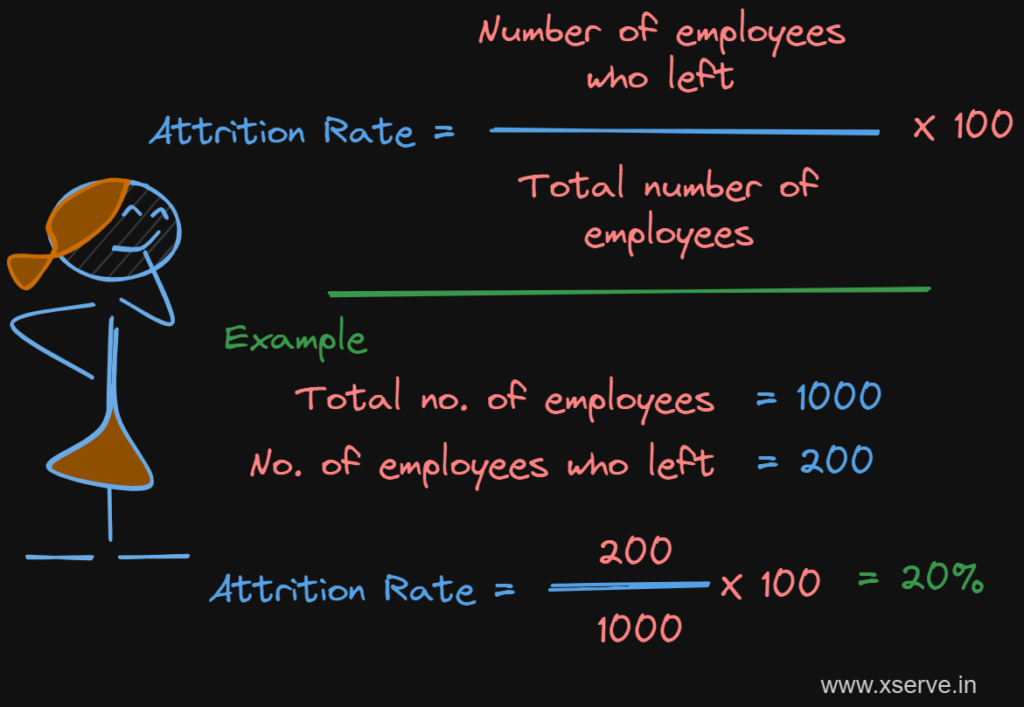Step into the world of the dynamic and ever-evolving BPO industry and you’ll quickly realize that attrition is a constant challenge. In this post, we unveil the step-by-step guide that will demystify the process of calculating attrition in the BPO industry.
Whether you’re a business owner, a manager, or an HR professional, understanding attrition is crucial for maintaining a flourishing workforce.
We will walk you through each stage of the attrition calculation process, breaking it down into simple and easy-to-follow steps. From defining attrition and its significance to collecting the necessary data and crunching the numbers, we’ll cover it all.
Discover the secrets to accurately calculating attrition rates, understanding the reasons behind employee churn, and gaining insights into how to effectively manage and reduce attrition in your BPO organization. By harnessing the power of data-driven decisions, you’ll be able to implement targeted strategies that will improve employee retention, drive productivity, and ultimately boost your bottom line.
So, let’s dive in and uncover the secrets of calculating attrition in the BPO industry!
Understanding the Importance of Calculating Attrition
High turnover in the BPO industry is a revolving door that costs companies time, money, and reputation.
Attrition, also known as employee churn, refers to the rate at which employees leave an organization over a specific period of time. In the context of the BPO industry, where talent retention is a significant concern, calculating attrition is essential for several reasons.
Firstly, calculating attrition allows businesses to identify the magnitude of their employee turnover problem. By quantifying attrition rates, organizations can gain a better understanding of their workforce stability and the potential impact on their operations.
Secondly, attrition rates provide valuable insights into the health of an organization. High attrition rates can indicate underlying issues such as poor management, work environment, or lack of employee engagement. Conversely, low attrition rates may suggest a positive work culture and effective talent management strategies.
Lastly, calculating attrition helps organizations forecast their future recruitment needs. By analysing historical data, businesses can anticipate patterns and trends, enabling them to plan for the hiring and training of new employees more effectively.
Key Factors Contributing to Attrition in the BPO Industry

Before delving into the process of calculating attrition, it is important to understand the key factors that contribute to attrition in the BPO industry. While attrition can result from a combination of factors, the following are some common causes:
- High-stress levels: The BPO industry is known for its high-pressure work environment, characterized by demanding targets, tight deadlines, and intense customer interactions. This constant stress can lead to burnout and ultimately drive employees to seek alternative employment.
- Limited career growth opportunities: Many BPO roles are perceived as entry-level positions with limited opportunities for career advancement. This lack of growth prospects can discourage employees from staying long-term, as they seek roles that offer more professional development and upward mobility.
- Monotonous work: BPO roles often involve repetitive tasks and standardized processes. This monotony can lead to employee disengagement and a lack of job satisfaction, prompting individuals to seek more fulfilling and challenging opportunities elsewhere. (Web story: A day in the life of an outsourcing executive)
- Inadequate compensation and benefits: In some cases, BPO organizations may not offer competitive compensation packages or attractive benefits, making it difficult to retain top talent. Employees may opt to leave for better remuneration and perks in other industries or competitors. (Read: How unexplained wage gap kills culture and happiness?)
- Work-life balance issues: The BPO industry typically operates on a 24/7 basis, requiring employees to work irregular hours and shifts. This can disrupt work-life balance, impacting personal relationships, health, and overall job satisfaction.
Understanding these factors is crucial as it allows organizations to address the root causes of attrition and implement targeted strategies to reduce turnover.
Step-by-Step Guide on How to Calculate Attrition
Now that we have established the importance of calculating attrition and identified the key factors contributing to attrition in the BPO industry, let’s dive into the step-by-step guide on how to calculate attrition rates.
Step 1: Gather and Analyse Attrition Data
The first step in calculating attrition is to gather relevant data pertaining to employee turnover. This data can be obtained from HR records, exit interviews, or employee surveys. It is important to collect data over a specific time period, such as a year or a quarter, to ensure accuracy and consistency.
Once the data is collected, it needs to be analysed to identify the number of employees who have left the organization during the specified time period. This can be done by categorizing departures into voluntary resignations, terminations, and retirements.
Step 2: Calculate Attrition Rate
To calculate the attrition rate, divide the number of employees who left during the specified time period by the total number of employees at the beginning of the same period. Multiply the result by 100 to convert it into a percentage.

Attrition Rate = (Number of Employees Who Left / Total Number of Employees) x 100
For example, if a BPO organization had 1000 employees at the beginning of the year and 200 employees left during that year, the attrition rate would be:
Attrition Rate = (200 / 1000) x 100 = 20%
Step 3: Interpret Attrition Rates and Trends
Once the attrition rate is calculated, it is important to interpret the results in the context of the organization’s goals and industry benchmarks. A high attrition rate may indicate underlying issues that need to be addressed, while a low attrition rate may suggest effective talent management strategies.
It is also essential to analyse attrition trends over time. Identifying patterns and fluctuations can provide valuable insights into the effectiveness of implemented retention strategies and the impact of external factors such as economic conditions or industry changes.
Strategies to Reduce Attrition in the BPO Industry

Calculating attrition rates is just the first step towards managing attrition effectively. To reduce attrition in the BPO industry, organizations need to implement targeted strategies that address the underlying causes and create a positive work environment.
Here are some effective strategies:
- Improve employee engagement: Foster a culture of open communication, recognition, and professional development opportunities to keep employees engaged and motivated.
- Offer competitive compensation and benefits: Ensure that employees are fairly compensated and provide attractive benefits packages to retain top talent.
- Provide growth opportunities: Create clear career paths and provide opportunities for skill development and advancement within the organization.
- Promote work-life balance: Implement flexible work arrangements and wellness programs to support employees’ personal and professional well-being.
- Enhance the work environment: Foster a positive work culture, promote teamwork, and provide a supportive and inclusive environment that values diversity.
By implementing these strategies and regularly monitoring attrition rates, organizations can effectively reduce employee turnover and build a loyal and committed workforce.
Gathering and analysing attrition data
To accurately calculate attrition rates in the BPO industry, the first step is to gather and analyse the relevant data. This involves collecting information on employee turnover, identifying key metrics, and understanding the underlying factors contributing to attrition.
Let’s delve deeper into each of these steps.
Step 1: Define attrition
Attrition refers to the rate at which employees leave a company over a specific period of time.
It is typically expressed as a percentage and is an essential metric for assessing the health of an organization’s workforce. Attrition can occur due to various reasons, such as job dissatisfaction, lack of growth opportunities, or better offers from competitors. By understanding attrition, organizations can identify areas for improvement and implement strategies to reduce turnover.
Step 2: Identify key metrics
To calculate attrition rates, you need to identify the key metrics that will provide insights into employee turnover. These metrics may include the number of employees who have left the company during a specific period (typically a year), the total number of employees at the beginning and end of that period, and any additional factors that may affect attrition, such as voluntary resignations, involuntary terminations, or retirements.
Step 3: Collect relevant data
Once you have defined attrition and identified the key metrics, the next step is to collect the relevant data. This can be done by accessing HR records, employee databases, or conducting surveys to gather information on employee turnover.
It is important to ensure that the data collected is accurate and up-to-date to ensure the validity of the attrition calculation.
Step 4: Crunching the numbers
Now that you have the necessary data, it’s time to crunch the numbers and calculate the attrition rate. The formula for calculating attrition is relatively straightforward:
Attrition Rate = (Number of employees who left / Total number of employees) * 100
For example, if a BPO organization had 100 employees at the beginning of the year, and 10 employees left during that year, the attrition rate would be:
Attrition Rate = (10 / 100) * 100 = 10%
By calculating attrition rates for different periods, such as monthly or quarterly, organizations can track trends and identify any patterns or fluctuations in employee turnover.
Interpreting attrition rates and trends
Once you have calculated the attrition rate, it’s important to interpret the results and gain insights into the reasons behind employee churn.
Understanding the underlying factors contributing to attrition can help organizations develop effective strategies to manage and reduce turnover. Let’s explore how to interpret attrition rates and trends.
Step 1: Analyse attrition rates
Analysing attrition rates involves looking at the calculated percentages and comparing them to industry benchmarks or historical data. This can provide a context for understanding the attrition rate and determining whether it is high or low.
For example, if the attrition rate is significantly higher than the industry average, it may indicate underlying issues within the organization that need to be addressed.
Step 2: Identify patterns and trends
In addition to analysing attrition rates, it’s important to identify any patterns or trends in employee turnover. This can be done by comparing attrition rates across different departments, job roles, or employee demographics.
By identifying patterns, organizations can gain insights into the factors that may be contributing to attrition and develop targeted strategies to address specific areas of concern.
Step 3: Understand the reasons behind attrition
To effectively manage and reduce attrition, it’s crucial to understand the reasons behind employee churn. This can be done through exit interviews, employee surveys, or by analysing feedback and complaints.
By identifying the root causes of attrition, organizations can take proactive measures to address these issues and create a more positive and engaging work environment.
Conclusion and final thoughts
Calculating attrition rates in the BPO industry is a vital process for understanding employee turnover and developing strategies to improve retention. By following the step-by-step guide outlined in this article, organizations can accurately calculate attrition rates, interpret the results, and gain insights into the underlying reasons behind employee churn.
Armed with this knowledge, organizations can implement targeted initiatives to reduce attrition, improve employee satisfaction, and ultimately drive business success.
Remember, attrition is not an isolated issue but rather a symptom of underlying problems within an organization.
By addressing these issues and creating a supportive and engaging work environment, BPO organizations can not only reduce attrition but also boost employee morale, productivity, and overall performance. So, start uncovering the secrets of calculating attrition in the BPO industry and take the first step towards building a thriving workforce.

